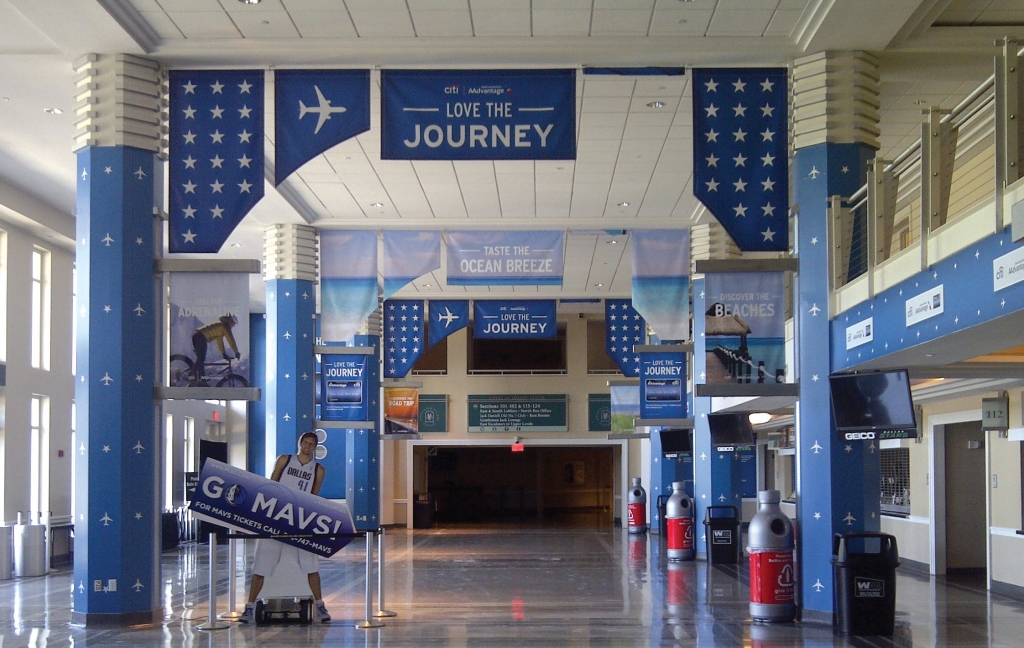Dallas’ American Airlines Center, home to the NBA’s Mavericks, the NHL’s Stars and numerous concerts, was built in 2001 for $420 million. It differs from many major-league, multi-purpose arenas because its many windows allow natural light into the facility (this makes sense in a warm-climate city; letting the dreary seep inside a New York arena would only add to locals’ angst and depression). An arena with an inviting persona deserves similarly attractive signage.
Center officials hired MetroMedia Technologies (MMT), NYC and Dallas, to create a banner program that recognizes Citicards, an arena sponsor and corporate partner with American Airlines’ Advantage travel-rewards program. Column wraps and other digital graphics comprise other program components. The sponsorship is expected to last at least a year, and possibly two.
As with most such jobs, the 20-banner, 2,700-sq.-ft. project had a quick, 10-day turnaround time from artwork submission, which was done with Adobe InDesign® software files, to installation. The artwork required slight revisions to ensure the banners accurately depicted Citi’s signature blue hue.
The banner program included two types; concourse banners, which were installed approximately 10 ft. above the floor, and ceiling-mounted signage. For both systems, MMT specified a 15-oz., double-sided, blockout media because each side of the banners contains separate messaging.
To print the banners, MMT used its Gandi Innovations Jeti 3300 solvent-ink printer. The shop’s proprietary RIP assisted with prepping files for printing, and the machine’s optical-registration system verified accurate layout on both material sides. Because the banners were installed inside, and in the arena’s north concourse, which creates far less UV degradation than southern exposure, the prints weren’t laminated.
The concourse banners, which stand 7 ft. tall, were produced as standard, square prints, so standard grommets, pole pockets and hardware were required. However, the ceiling banners have an irregular shape – the ceiling forms an arch. Thus, these banners’ upper portions follow the form. To fortify them, MMT fabricated custom brackets in-house that fit into a small pocket at each banners’ lower end. An aluminum plate, with a protruding panel and a small post, inserts into a round, PVC pipe, through which ¼-in.-thick, steel cable was run through to stabilize the banners and minimize motion.
Advertisement
MMT brought a 30-ft.-reach, scissor lift into the facility to complete installation. Unlike most commercial installations, where the installer must work by night to not intrude upon daytime customers, MMT had to quit work by 3 p.m. each day to not interfere with each evening’s events. Alas, every installation provides challenges.
“When we began the project, we weren’t warned about the laser-beam sensor on the ceiling that trips off the smoke alarm,” Paul Calce, MMT’s account executive who sold the project, said. “We had to take those banners down and wait a few days for the smoke alarm to be moved. A problem-free installation is rare.”



 Tip Sheet1 week ago
Tip Sheet1 week ago
 Photo Gallery2 days ago
Photo Gallery2 days ago
 Ask Signs of the Times4 days ago
Ask Signs of the Times4 days ago
 Real Deal2 weeks ago
Real Deal2 weeks ago
 Benchmarks7 days ago
Benchmarks7 days ago
 Women in Signs2 weeks ago
Women in Signs2 weeks ago
 Photo Gallery1 week ago
Photo Gallery1 week ago
 Women in Signs1 week ago
Women in Signs1 week ago







